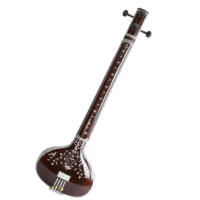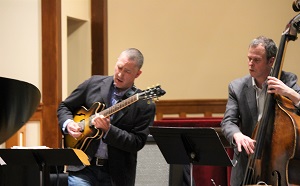Think about your favorite musical artist and the instruments they play. Bruce Springsteen, on guitar, keyboard, or harmonica? Jerry Garcia on guitar or banjo? Prince on the keyboard, guitar, or 20 more? So many well-known artists of the past century are skilled on more than one instrument. You may not aspire to be an award-winning musician, but learning a second instrument – at any age – can enhance your musical knowledge and appreciation.
[Read more about famous multi-instrumentalists]
Learning a second instrument highlights aspects of music you may not have focused on with your first instrument– and can introduce completely new ones. As Ontario’s Music Studio explains, people who learn monophonic instruments like the clarinet or trumpet may be more familiar with melody than harmony. A violinist plays music written in the treble clef, and a cellist in the bass clef, but not vice versa. And a guitarist in a rock band is not responsible for keeping the beat the same way a bassist or drummer is. By picking up a second instrument, you are not just learning the mechanics of playing but expanding your knowledge of music in general. 
Learning the piano as a second instrument can improve your understanding of music theory. As instructor Doreen Hall writes, sitting at the 88 keys is like having a “map of scales, intervals, and chords” laid out in front of you. Because the piano is so important in learning theory, keyboard courses are required at music schools and conservatories.
Or, let’s say the piano is your first instrument – you may be used to being a solo act. By choosing a second instrument conducive to a band or ensemble, you will gain the opportunity to play with others, greatly enhancing your listening skills.
You’ll notice a difference in your performance with your first instrument. Think about studying a foreign language in school. Week by week, you tackled grammar rules and learned new vocabulary. You developed skills in the new language and a more fundamental understanding of your first language. Similarly, you will transfer your knowledge and skills – focus on rhythm, a better understanding of theory – back to your first instrument.
As Musical U writes, you can speak the same language as other musicians in your band or ensemble when you are a multi-instrumentalist. “When the drummer starts talking about a rhythm that sounds like “Claka-claka-dum-dum-splash,” you know what they are saying.” You’re able to understand the piece of music you both are working on from your bandmate’s perspective. 
How about better supporting yourself? CCM Voice Faculty Greta Feeney studied chant and decided to learn an instrument that pairs well: the tanpura. The tanpura is a traditional Indian long-necked string instrument with a base made from a dried gourd. It produces a rich, drone-like sound that is used to support vocals. Greta has acquired a tanpura and is excited to use it to enrich her chant.
For an example of the opportunities a new instrument can bring, ask CCM Cello Faculty Steve Marotto. During the Covid-19 lockdown, Steve picked up the mandolin he had lying around his house. As both the cello and mandolin are tuned in fifths, many finger patterns and chord shapes in the left hand translate. The right hand is entirely different, though – Steve had to go from bowing the cello to plucking the mandolin. And that was just the start.
As Steve explains, the mandolin has opened the door to an entirely new music genre: bluegrass. Cellos are uncommon in bluegrass bands where the lower register is covered by the bass, and the higher register by the banjo and guitar. The mandolin is a key instrument in such groups.
The mandolin also has a different role to play than Steve is used to when performing on the cello. While both cello and mandolin provide the melody, the mandolin can also “function as a percussive instrument,” Steve says. He likens chop chords to a snare drum that marks the beat.
Steve has taken up lessons with CCM Mandolin faculty member Maxfield Anderson. Max is teaching him the oral tradition of bluegrass as well as playing techniques. Steve aims to play in string bands when the music scene comes back, which would be very difficult to do on the cello.

Aspiring to a career in music? Learning a second instrument can help you get gigs. You will be an asset to a band or orchestra if you can fill in for a fellow musician. Ensembles in particular benefit from musicians who can double on related instruments – flute with piccolo, violin with viola, clarinet with bass clarinet, etc. And, if you’d like to teach private lessons or lead ensembles someday, knowing more than one instrument gives you the insight employers are looking for when hiring.
Think about everything you already know about music – note names, scales, and rhythms. You had to learn to read music while you were starting to play your first instrument. Learning your second will be so much easier with all that knowledge already in your back pocket.
So you’re ready to take on a second instrument – that’s great! Here’s what to do next:
What are your goals for the second instrument? Is there one whose sound has always appealed to you? Or, if your goal is to get hired, how about an instrument in the same family as your first?
Depending on your chosen instrument’s type and corresponding price, you may wish to rent before making the final commitment. Some businesses have rent-to-buy options for just this purpose. More tips about acquiring:
Below are businesses we work closely with and recommend for their professionalism and high-quality instruments.
Strings
Piano
M. Steinert & Sons, a special CCM partner. Our students will receive a discount on a piano purchase or on the monthly piano rental rate from Steinert. Additionally, CCM will also receive a portion of proceeds from piano purchases, which helps us provide a music education to everyone!
Woodwind & Brass
Guitars, Mandolins, Banjos
The Music Emporium
3. Sign Up for Lessons
Call or send us an email to discuss lessons here at CCM. We will set you up with an instructor at the top of their field who will teach you the mechanics of playing your new instrument and music theory, ear training, and more. We also have performance opportunities – recitals for school-aged students and adult soirees.
More Resources:
6 Benefits of Learning a Second Instrument
The Piano as a Second Instrument
Why You Should Pick Up a Second Instrument
Back To Top